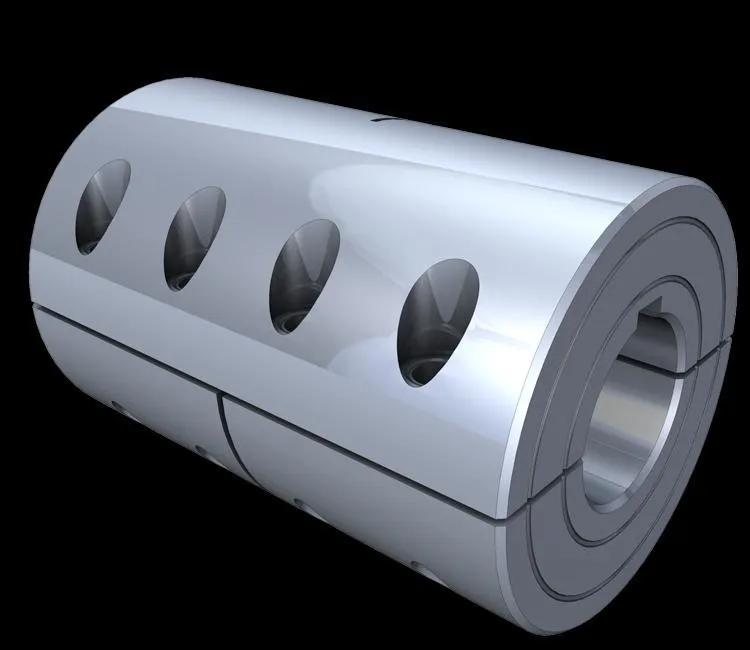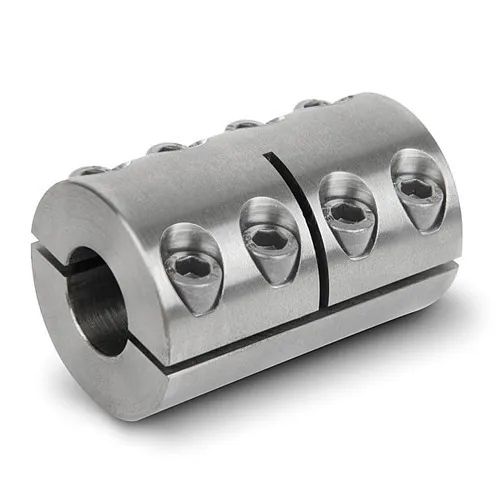Product Description
High Quality Steel Tooth Flexible Rubber Plastic falk flexible nylon sleeve universal joints chainbox muff Gear Coupling replacement of bowex coupling
Application of Gear Coupling
Gear couplings are used to connect 2 shafts that are not perfectly aligned. They are made up of 2 gears that mesh together, and the teeth of the gears allow the shafts to rotate at different speeds without binding. Gear couplings are available in a variety of sizes and styles, and they can be used in a wide range of applications.
Some of the most common applications for gear couplings include:
- Machine tools: Gear couplings are used in machine tools to connect the motor to the cutting tool. This allows the cutting tool to operate at a high speed and torque, which is necessary for cutting through tough materials.
- Wind turbines: Gear couplings are used in wind turbines to connect the blades to the generator. This allows the generator to generate electricity at a controlled speed and torque, which is necessary for providing power to homes and businesses.
- Robotics: Gear couplings are used in robotics to connect the motor to the robot’s joints. This allows the robot to move its joints at a controlled speed and torque, which is necessary for performing tasks such as picking and placing objects.
- Conveyors: Gear couplings are used in conveyors to connect the motor to the conveyor belt. This allows the conveyor belt to move at a controlled speed and torque.
- Mining: Gear couplings are used in mining equipment, such as crushers, conveyors, and pumps. The coupling allows the equipment to move materials at a controlled speed and torque, which is necessary for mining operations.
- Construction: Gear couplings are used in construction equipment, such as excavators, cranes, and loaders. The coupling allows the machinery to move at a controlled speed and torque, which is necessary for construction operations.
- Aerospace: Gear couplings are used in aerospace applications, such as jet engines and helicopters. The coupling allows the engines to operate at a controlled speed and torque, which is necessary for flight.
Gear couplings are a versatile and valuable tool for a variety of applications. They can be used to connect 2 shafts that are not perfectly aligned, and they can be used in a wide range of industries.
Here are some of the benefits of using gear couplings:
- Increased efficiency: Gear couplings can help to improve efficiency by reducing friction and vibration.
- Reduced wear and tear: Gear couplings can help to reduce wear and tear on the shafts and gears.
- Improved safety: Gear couplings can help to improve safety by preventing shafts from becoming misaligned.
- Increased versatility: Gear couplings can be used in a wide range of applications.
If you need to connect 2 shafts that are not perfectly aligned, then a gear coupling may be the right solution for you.
/* March 10, 2571 17:59:20 */!function(){function s(e,r){var a,o={};try{e&&e.split(“,”).forEach(function(e,t){e&&(a=e.match(/(.*?):(.*)$/))&&1

What are the best practices for ensuring proper lubrication of muff couplings?
Proper lubrication is essential for the efficient and reliable operation of muff couplings. Here are the best practices to ensure optimal lubrication:
- Select the Right Lubricant: Choose a lubricant that is suitable for the operating conditions of the muff coupling, including factors such as temperature, load, speed, and environment. Consult the manufacturer’s recommendations for lubricant type and viscosity.
- Apply Adequate Amount: Apply the correct amount of lubricant to ensure that all relevant surfaces within the muff coupling are adequately coated. Insufficient lubrication can lead to increased friction and wear, while excess lubrication can lead to overheating and contamination.
- Regular Inspection: Regularly inspect the muff coupling’s lubrication levels to ensure they remain within the recommended range. Conduct visual inspections or use lubrication monitoring tools to assess lubricant condition and coverage.
- Cleanliness: Ensure that the coupling components are clean before applying lubricant. Contaminants can compromise the lubricant’s effectiveness and contribute to wear and corrosion.
- Frequent Re-Lubrication: In applications with high demands or harsh conditions, consider implementing a re-lubrication schedule to maintain consistent lubrication levels. Factors like operating hours, temperature changes, and load fluctuations can influence the frequency of re-lubrication.
- Apply at Proper Points: Apply lubricant to the specific points indicated by the muff coupling’s manufacturer. These points are strategically located to ensure proper lubrication of critical components.
- Monitor Lubricant Quality: Regularly analyze the quality of the lubricant through oil analysis techniques. This can help detect contamination, degradation, and other issues that may affect lubrication performance.
- Use Lubrication Guidelines: Follow the lubrication guidelines provided by the muff coupling manufacturer. These guidelines typically include recommended lubrication intervals, lubricant types, and application methods.
- Consider Sealing: In applications exposed to harsh environments or contaminants, consider using sealed or encapsulated muff couplings that help retain the lubricant and protect against external factors.
- Temperature Consideration: Take into account the operating temperature range of the muff coupling when selecting a lubricant. Extreme temperatures can affect lubricant viscosity and performance.
By following these best practices, you can ensure proper lubrication of muff couplings, promoting their longevity, efficiency, and overall performance in machinery systems.

Are there any industry standards or guidelines for designing and using muff couplings?
Yes, there are industry standards and guidelines that provide recommendations and specifications for designing and using muff couplings in various applications. These standards ensure that muff couplings are designed and utilized safely and efficiently. Here are some notable industry standards:
- ISO 10822: This International Organization for Standardization (ISO) standard provides guidelines for the design and selection of flexible shaft couplings, including muff couplings. It covers dimensions, tolerances, and performance criteria.
- API 671: The American Petroleum Institute (API) standard 671 focuses on special purpose couplings for petroleum, chemical, and gas industry services. It includes specifications for design, manufacturing, and testing of various couplings, including muff couplings.
- AGMA 9002: The American Gear Manufacturers Association (AGMA) standard 9002 provides guidelines for the design and selection of gear couplings, which includes muff couplings used in gear systems. It covers design considerations, materials, and performance requirements.
- DIN 9611: The German Institute for Standardization (DIN) standard 9611 provides specifications for flange couplings and muff couplings used in hydraulic systems. It covers dimensions, tolerances, and testing procedures.
- Manufacturer’s Guidelines: Many muff coupling manufacturers provide their own guidelines and specifications for proper design, installation, and usage of their products. These guidelines should be followed closely to ensure optimal performance and safety.
It’s important to consult the relevant industry standards and manufacturer’s guidelines when designing, selecting, and using muff couplings. Adhering to these standards helps ensure that muff couplings are correctly sized, installed, and maintained for their intended applications, promoting safe and efficient machinery operation.

Are there any maintenance tips to ensure the longevity of a muff coupling?
Maintaining a muff coupling is crucial to ensure its longevity and reliable performance in machinery. Here are some maintenance tips to help extend the lifespan of a muff coupling:
- Lubrication: Regularly lubricate the contact surfaces between the muff coupling sleeves and the shafts. Lubrication reduces friction, minimizes wear, and prevents corrosion. Use lubricants recommended by the manufacturer.
- Inspection: Periodically inspect the muff coupling for signs of wear, damage, or misalignment. Check for any unusual vibrations, noises, or irregularities during operation.
- Tightening: Ensure that fasteners, such as bolts or screws, are properly tightened according to the manufacturer’s specifications. Loose fasteners can lead to misalignment and premature wear.
- Alignment: Maintain proper shaft alignment to prevent excessive stresses on the muff coupling. Misalignment can result in increased wear and reduced coupling performance.
- Cleaning: Keep the muff coupling and its surroundings clean from debris, dirt, and contaminants. This prevents foreign particles from causing abrasion and damage.
- Corrosion Protection: If the muff coupling is exposed to corrosive environments, apply appropriate coatings or treatments to protect the coupling from rust and corrosion.
- Replacement of Components: If any components of the muff coupling, such as keys or fasteners, show signs of wear or damage, replace them promptly to maintain coupling integrity.
- Regular Maintenance Schedule: Develop a regular maintenance schedule that includes inspections, lubrication, and other necessary tasks. Adhering to a maintenance routine can prevent unexpected failures and downtime.
- Operating Conditions: Operate the machinery within the recommended operating conditions specified by the manufacturer. Avoid overloading the muff coupling, which can lead to premature wear and failure.
- Training: Provide training to maintenance personnel on proper installation, alignment, and maintenance procedures for muff couplings. Knowledgeable maintenance teams can identify issues early and address them effectively.
Following these maintenance tips ensures that the muff coupling continues to perform optimally, reduces the risk of unplanned downtime, and extends the overall lifespan of the coupling.


editor by CX 2024-01-12
